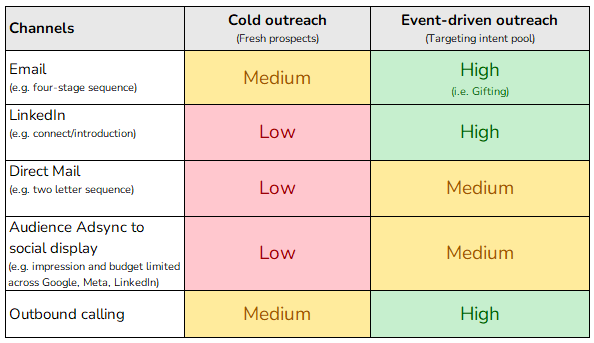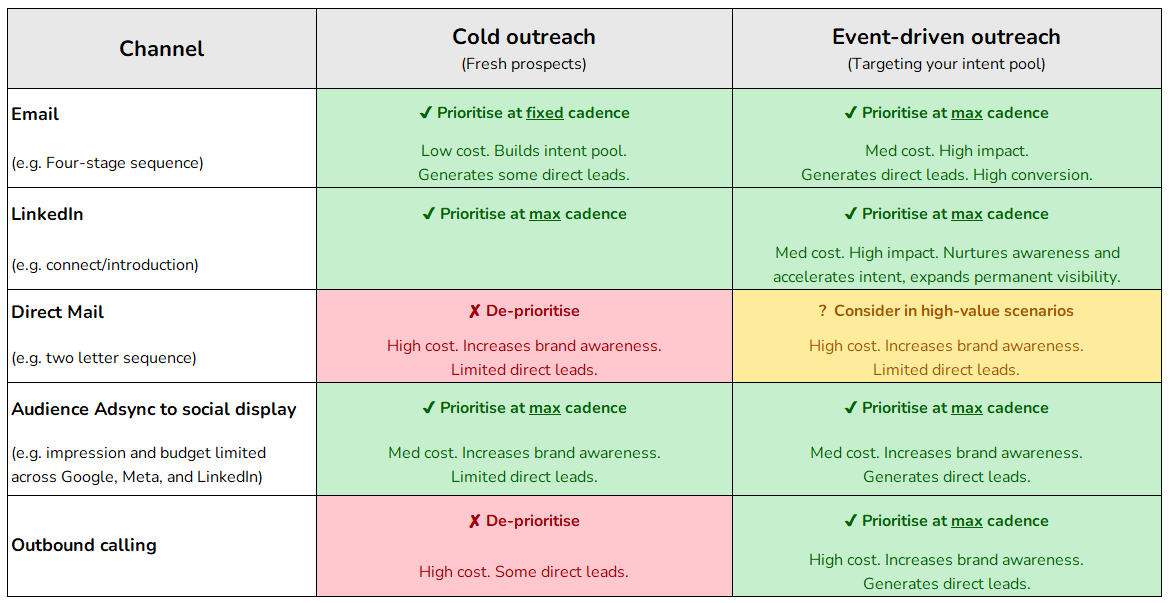Multi-channel outreach cadence management – black belt edition

B2B sales outreach has become a complicated integrated operation, with multiple channels working together. But how do you optimise, prioritise, and set audience engagement volumes for each channel?
With differing exposure guidelines, unit economics and volume limitations in play across key outreach channels, if you haven’t yet mastered a multi-channel cadence management strategy… then you’re in luck.
If you’re a business selling to other businesses and tackling the rapidly evolving go-to-market (GTM) field, this post is for you.
Let’s start with your channels and then look at the volumes.
Picking your outreach channels
I’m going to assume you have the basic channel operations in place, and your headline sales outreach strategy looks something like this:
| Email (e.g. four-stage sequence) | ✔ |
| LinkedIn (e.g. Connect/introduction) | ✔ |
| Direct mail (e.g. two-letter sequence) | ✔ |
| Audience Adsync to social display (e.g. impression and budget limited across Google, Meta, and LinkedIn) | ✔ |
| Outbound calling | ✔ |
This is broadly how we structure sales engagement at Sopro. (I appreciate we haven’t got to cadence management yet… if the groundwork above already sounds like a tall order to run in-house, then I suggest you back up and give Steve Harlow a shout).
Now let’s get to volumes.
Multi-channel outreach audience volumes
First, here’s a Total Addressable Market (TAM) breakdown for a typical audience of 20,000 qualified companies.
Total Addressable Market (TAM)
| Audience size | Value |
|---|---|
| Qualified companies | 20,000 |
| Prospects per company | 2.7 |
| Qualified prospects | 54,000 |
| 10% reduction (QA and exclusions) | 90% |
| Eligible prospects | 48,600 |
Once we have the TAM mapped, actually reaching them is driven by data availability. Each channel requires specific fields to enable engagement, so your data append success rates will determine the number of reachable prospects per channel.
Below is a typical audience append profile. The match rates give us the reachable audience per channel.
Data buckets by channel
| Channel | Match rate | Prospects |
|---|---|---|
| Prospect profile sourced | 100% | 44,591 |
| Email found and delivered | 70% | 31,142 |
| Social Adsync match % | 45% | 20,066 |
| Mobile phone find % | 40% | 17,836 |
| Address find % | 65% | 28,984 |
The seven-month outreach cycle
Next, I’m going to present the audience based on a seven-month cycle. This is a central theme, so I’ll just explain it here.
In essence, you don’t want to be cycling through your audience too fast. It becomes counterproductive. Thousands of GTM campaigns have taught us that a six-month cool-off period between one-month outreach cycles is a great way to ensure a strong results profile without crossing the line into intrusiveness. (6+1=7)
Based on a seven-month cycle, you can target up to 1/7 of your addressable audience per month, indefinitely, without risking overexposure.
Here are the channel buckets on that basis.
Monthly channel cadence (based on a seven-month cycle)
| Cold engagement | Max per cycle | Max monthly |
|---|---|---|
| 31,142 | 4,449 | |
| 44,591 | 6,370 | |
| Audience Adsync | 20,066 | 20,066 |
| Outbound calling | 17,836 | 2,548 |
| Direct mail | 28,984 | 4,141 |
So those are our cold outreach audiences per channel.
But that’s only half the strategy.
In 2024, very few B2B operators successfully convert prospects with an exclusively cold engagement strategy.
Incorporating intent-based re-engagement
To underscore the importance of using intent-driven activity as a core element of your GTM model, in parallel to cold outreach, here’s a handy page I ripped straight from the Sopro value proposition doc.
Essentially, your customers have three clear stages of awareness. Each is a strong indicator of proximity to purchase and warrants entirely different treatments.
By monitoring intent signals, we can clearly differentiate the segment of your audience that is aware of and engaging with your brand.
This could be when a prospect visits your site, accepts your connection request, responds to your email, etc.
This activity allows a clear differentiation between cold outreach and intent-driven premium engagement.
At Sopro, around 12% of companies in the TAM demonstrate intent over a full outreach cycle, becoming eligible for premium intent-driven outreach.
Critically, this 12% yields a disproportionally high percentage of deals won.
Let’s see how our TAM breaks down with the intent pool added to the mix.
Channel cadence (based on a seven-month cycle)
| Cold engagement | Full cycle | Max monthly |
|---|---|---|
| 31,142 | 4,449 | |
| 44,591 | 6,370 | |
| Audience Adsync | 20,066 | 20,066 |
| Outbound calling | 17,836 | 2,548 |
| Direct mail | 28,984 | 4,141 |
| Intent pool – premium engagement | Full cycle | Max monthly |
|---|---|---|
| Email (web visitors using IP Match and Engage) | 1,869 | 267 |
| LinkedIn (Event-driven custom engagement) | 2,675 | 382 |
| Audience Adsync (Google, Meta, LinkedIn – Intent Pool Audience) | 2,048 | 2,048 |
| Outbound calling (Mobile phone number sourced for client use) | 1,070 | 153 |
| Direct mail (optional, billable per unit) | 1,739 | 248 |
So these are theoretical channel maximums at a raw data level. But would you really max out all these channels at full volume all the time?
Limitations, cost and impact
To answer that, we need the unit economics, impact of engagement, and technical limitations by channel, which are approximated here.
| Channel | Technical limitations | Fully loaded unit cost (guide) |
|---|---|---|
| Email (e.g. four-stage sequence) | Deliverability limitations (suggested) (Max 3,000 sequences/month per Agent) | £1 – £3 |
| LinkedIn (e.g. connect/introduction) | LinkedIn invitation limitations (~500/month per Agent) | £1 – £3 |
| Direct mail (e.g. two letter sequence) | No limitations | £2 – £4 |
| Audience Adsync to social display (e.g. impression and budget limited across Google, Meta, LinkedIn) | No limitations | £1,000 (total/month) |
| Outbound calling | No limitations | £5 – £10 |
Your fully loaded costs will vary based on a wide range of elements: the specific internal and external resources assigned, the price of the design agency prepping your Direct Mail templates, whether your outbound calling is using a call centre or internal resource, and so on.
But the ballpark figures above won’t be miles off.
In addition to the variance in pricing, your channels perform very differently when it comes to converting prospects from any given state of awareness to a sales opportunity.
Here’s how that looks.
Engagement value by channel

By comparing channel costs and impact like this, we can set the channel prioritisation model for most B2B multi-channel outreach scenarios. Feel free to use this.

Now all we need to do is combine the prioritization matrix above with our TAM data buckets, and hey presto, here’s what you can expect in terms of monthly activity by channel:
Multi-channel cadence example
You’re welcome. Now go forth and configure your multi-channel GTM.
Want to take your multi-channel strategy to the next level? You need a multi-channel marketing agency that’s well-versed in getting real, tangible results.
Where do results come from?
Here’s an example of the all-bound GTM channel mix in action (the example shows monthly cadence figures from the example audience size used above).
So there you have it, multi-channel cadence management in a nutshell.
If my post makes you feel like the nut trapped in the shell, rather than the hungry person with the nutcracker, you might want to think about engaging Sopro’s demand generation service.







Share